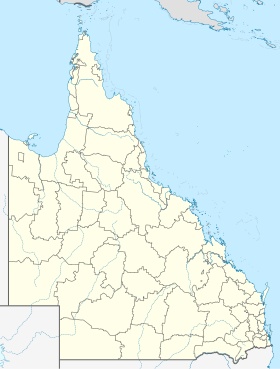Chillagoe
| Chillagoe | |||||||
|---|---|---|---|---|---|---|---|
 Limestone cliff at Chillagoe |
|||||||
|
|||||||
|
|||||||
|
|||||||
|
|||||||
|
|
|||||||
Chillagoe is a small town in the northeast of the Australian state of Queensland . It was once a prosperous mining settlement, where various minerals were mined in the vicinity . Today there is only a small zinc mine and a few marble quarries . In the 2016 census, 188 inhabitants were counted.
Chillagoe Mungana Caves National Park lies south and north of the city on Burke Developmental Road . There are 600–1000 caves in the area around Chillagoe and Mungana . These caves, the spectacular karst landscape and the history of the mining industry are the main tourist attractions in this area.
Leading geology professor Ian Plimer found that the Chillagoe area has the greatest geological diversity of any area in the world.
history
Chillagoe got its name from William Atherton in 1888 . It came from a shanty refrain: "Hikey, Tikey, Psyche, Crikey, Chillagoe, Walabadorie". James Mulligan explored the area in 1873 and Atherton confirmed his report of rich copper in the area. Mining pioneer John Moffat sent prospectors into the copper field in 1888 and soon received a monopoly for its mining . A registration authority opened in 1891 (W. Atherton was the registration officer), but closed again in 1893. In 1900 a post office was opened and F. Donner was the post officer in charge. The railway line of the Chillagoe Railway and Mining Company led from 1901 to Mareeba and on October 27, 1910 a settlement area was designated for the city.
Chillagoe is also remembered for its involvement in the Mungana affair , a mining scandal that led to the overthrow of the government. In 1919 the state of Queensland became the owner of the smelting furnaces after the changeable success of the previous owners and several closings. This acquisition, carried out by the Labor government, sparked rumors of corruption that persisted for years. At the end of the 1920s, the furnace plants were again affected by closings. When the Australian Labor Party had to relinquish power in 1929, the new government set up a Royal Commission to investigate what was going on. The political careers of two former Queensland Prime Ministers, Ted Theodore and McCormack , have been ruined by the Commission's report.
Woothakata is a property on Chillagoe Creek named after the former shire of the northern table country to which Chillagoe once belonged. Woothakata is an Aboriginal word that describes the way the Aborigines once traveled to Ngarrabullgan / Mount Mulligan , an important gathering place.
Web links
Individual evidence
- ↑ a b Australian Bureau of Statistics : Chillagoe (L) ( English ) In: 2016 Census QuickStats . June 27, 2017. Retrieved April 13, 2020.
- ^ RF Ellis: The Chillagoe Railway and Mining Company . Australian Railway Historical Society Bulletin (December 1976, January-April 1977). Pp. 270-291, 16-23, 62-81
- ^ GC Bolton: A Thousand Miles Away: A History of North Queensland to 1920 . Australian National University Press (1975). ISBN 0708100910
- ^ Joan Frew: Queensland Post Offices 1842-1980 and Receiving Offices 1869-1927 . Fortitude Valley QLD 1981. Self-published by the author. ISBN 0-9593973-0-2 . P. 235
